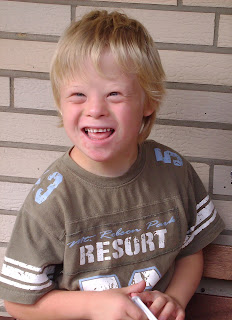 |
| Image credit to wikimedia commons |
If you want to do favors for me then click on one of the advertisement
Introduction:-
Down syndrome is a genetic disorder that affects individuals from all races and ethnicities worldwide. It is caused by an extra copy of chromosome 21, which results in various physical and cognitive developmental delays.
People with Down syndrome have unique physical characteristics, such as
1) almond-shaped eyes,
2) a small stature,
3) and a flat nasal bridge.
These characteristics have led to a significant stigma surrounding the condition, and many individuals with Down syndrome experience discrimination and marginalization.
However, with proper education and support, individuals with Down syndrome can lead fulfilling lives and contribute positively to their communities.
Definition of Down syndrome:-
Down syndrome is a genetic disorder caused by trisomy 21 ( extra copy of chromosome 21). This extra chromosome results in various developmental delays and physical characteristics, including cognitive delays, almond-shaped eyes, and small stature.
Symptoms and Signs of down syndrome:-
The symptoms and signs of Down syndrome can vary in severity, but some common physical characteristics include,
a small stature and short neck,
almond-shaped eyes that slant upwards and outwards,
a flat nasal bridge,
a small mouth with a protruding tongue,
a single crease across present on the palm of the hand,
a wide space between the first and second fingers of the toes.
In addition to these physical characteristics, people with Down syndrome may also experience cognitive delays and other health complications, such as congenital heart defects, respiratory problems, hearing loss, vision problems, digestive problems, thyroid problems, and leukemia.
Diagnosis
Down syndrome can be diagnosed before birth or after birth.
Prenatal testing, such as
chorionic villus sampling (CVS) or amniocentesis, can detect Down syndrome during pregnancy.
After birth:- a diagnosis of Down syndrome is typically based on physical characteristics and confirmed with genetic testing.
Treatment and Rehabilitation
There is no cure for Down syndrome, but early intervention and treatment can help individuals with Down syndrome reach their full potential. Early intervention typically involves therapies such as physical therapy, occupational therapy, and speech therapy. These therapies can help individuals with Down syndrome develop gross motor skills, fine motor skills, and communication skills.
In addition to early intervention, individuals with Down syndrome may benefit from ongoing medical care and support. Regular check-ups with a healthcare provider can help identify and manage any health complications associated with Down syndrome. Individuals with Down syndrome may also benefit from social support and inclusion programs that help them build relationships and participate in their communities.
Overview
Down syndrome is a genetic disorder caused by an extra copy of chromosome 21 or trisomy 21. People with Down syndrome have unique physical characteristics, such as 1) almond-shaped eyes,
2) a small stature, and a flat nasal bridge. They may also experience cognitive delays and other health complications. While there is no cure for Down syndrome, early intervention, and ongoing medical care can help individuals with Down syndrome reach their full potential. With proper support and education, individuals with Down syndrome can lead fulfilling lives and contribute positively to their communities.


Post a Comment